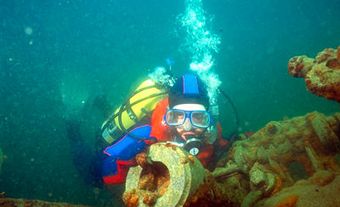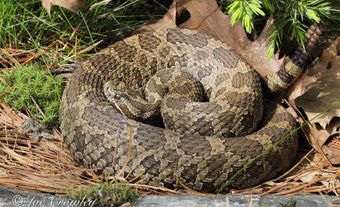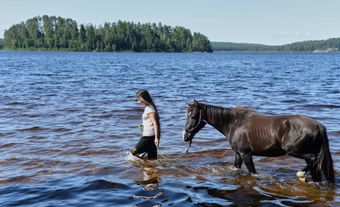Geography
The District Municipality of Muskoka occupies an area of 6,475 km2 in Southern Ontario that includes the towns of Bracebridge, Gravenhurst and Huntsville, as well as the townships of Georgian Bay, Lake of Bays and Muskoka Lakes. The Wahta Mohawk and Moose Deer Point First Nations also have reserves located within Muskoka’s boundaries (see also Reserves in Ontario).
Muskoka is part of Ontario’s larger cottage country whose population swells with seasonal residents and tourists, especially in the warmer months. It is known for its rugged landscape and natural splendour, from the windswept pines, rocky shores and turquoise waters of Georgian Bay in the west to the thick forest, freshwater lakes and abundant wildlife where Muskoka borders on Algonquin Park in the east. The district contains 1,600 lakes; the largest and most well-known are Lakes Joseph, Muskoka and Rosseau, which are interconnected. In total, Muskoka contains 19 watersheds, all beginning in Algonquin Park and flowing westward before emptying into Georgian Bay.
Though much of Muskoka’s islands and waterfront properties are privately owned, the district contains Georgian Bay Islands National Park and the provincial parks of Arrowhead, Hardy Lake, Ragged Falls and Six Mile Lake. A portion of Muskoka is crown land, including the 4,700-acre Torrance Barrens Conservation Reserve, the first dark sky reserve in Canada.

Geology
Embedded in the southern tip of the Canadian Shield, Muskoka’s landscape is marked by rugged rock formations, its lakes and rivers having been carved into the Shield in prehistoric times by retreating glaciers. Its formations of gneiss, granite and other volcanic rock, forged at least one billion years ago during the Precambrian era, are among the oldest on Earth. Muskoka’s rocky terrain presents a dramatic contrast to the gentle, agricultural Interior Platform topography to the immediate south. Sheer rock faces line the highways that pass through the district, the terrain having been levelled for roadways by blasting.
Flora and Fauna

While much of the Canadian Shield is dominated by the boreal forest ecosystem, the District Municipality of Muskoka is part of the Great Lakes-St. Lawrence forest region. It is a transitional area between the coniferous forests to the north and the deciduous forests to the south. Muskoka is known for its towering eastern white pines and is also home to many other evergreen trees, including the jack pine, red pine, eastern red cedar, eastern white cedar, eastern hemlock and the black, red, and white spruce. These softwood trees, most of which were cleared during the Muskoka lumber boom of the late 19th and early 20th centuries, have since regrown. Hardwood species in the region include basswood, red maple, sugar maple, beech, red oak, white oak, and the iconic yellow birch. The fall colours of Muskoka forests attract tourists from all over the world.
Moss and lichen grow on Muskoka’s forest floor and rocks. Trilliums are plentiful in the spring, while wild raspberries and blueberries are common in summer (see also Wild Berries).
Muskoka’s year-round canopy of trees, variety of plants and thousands of kilometres of shoreline provide habitats for many wild animals. The area is home to more than 250 species of birds, nearly 50 kinds of mammals, 25 types of reptiles and amphibians, and dozens of species of fish. Black bears, white-tailed deer, chipmunks, blue herons and loons are all common sights throughout the region. The Eastern massasauga rattlesnake is heard along the eastern shores of Georgian Bay. Anglers fish for trout, pike and bass.
Residential development is one of the main threats to Muskoka’s ecosystems. In response to this challenge, the Muskoka Lakes Association advocates for sustainable development and monitors water quality closely. Invasive plant species such as the European common reed, Japanese knotweed and giant hogweed also challenge the environmental balance of the region.
Indigenous Peoples
The District Municipality of Muskoka lies on the traditional territory of the Anishinaabeg, specifically the Ojibwe. The name Muskoka is likely a corruption of Misquuckkey (or Mesqua Ukie), the name of an Ojibwe chief who was a signatory to Treaty 16 in November 1815. This treaty concerns a parcel of land south of Muskoka, near Lake Simcoe.
The Moose Deer Point First Nation, located west of Port Carling, on Georgian Bay, descends from a group of Pottawatomi from the midwestern United States who moved to what is now Southern Ontario in the 1830s on invitation by the British government, whom they supported in the War of 1812.
The Ojibwe settlement of Obajewanung (“gathering place”), at present-day Port Carling, predated the arrival of Europeans to the Muskoka area. It was surveyed in 1860 by Vernon Wadsworth, who documented 20 Ojibwe homes in addition to farmland. As more White settlers arrived, the residents of Obajewanung were forced to relocate to Parry Island, near Parry Sound. The island’s rocky landscape could not be farmed, making survival difficult for the community. Ojibwe continued to spend summers in Port Carling for decades after the relocation.
In 1881, a group of Protestant Haudenosaunee (Iroquois) relocated to Muskoka from Kanehsatà:ke, near Oka, Quebec, after a dispute with the Catholic Church over land and religion. The community they founded continues today as the Wahta Mohawk reserve, located just west of the town of Bala. The Wahta Mohawks share an additional reserve called Indian River with the Chippewas of Rama. It occupies one hectare next to Port Carling. (See also Reserves in Ontario; First Nations in Ontario.) First Nations in the area are signatories to the Williams Treaties, created in 1923. In addition, the District Municipality of Muskoka is home to the Moon River Métis, whose administrative offices are located in Gravenhurst.
European Settlement
Early Europeans to visit the area were explorer Samuel de Champlain in 1615 and lieutenant-governor John Graves Simcoe in 1793. In 1837, David Thompson searched the region for a practical route from Ottawa to Lake Huron.
The Muskoka area was opened to settlement when Ontario’s Free Grants and Homestead Act (1868) made land available to farmers. Muskoka’s first townships, now amalgamated into the Township of Muskoka Lakes, were established near Port Carling, known as “The Hub of the Lakes.” Lured by free acreage, thousands of homesteaders arrived in Muskoka. They found some arable land interspersed among the rock and forest, but soil was generally not deep or rich enough to farm beyond subsistence level. Logging and tourism were much more lucrative enterprises, and many local farmers supplemented their income in those industries. Carpenters built cottages, for example, and former farmers ran successful hotels. Others supplied hotels with food.

Development
Early Lumber Trade, Agriculture and Tourism
In 1875, the extension of the Northern Railway of Canada to Gravenhurst, a town on the southern tip of Lake Muskoka and the gateway to the region, marked the beginning of rail service to Muskoka. Lumber could be shipped out and tourists brought in via train. The sawmill industry thrived during the late 19th and early 20th centuries; at one point, there were 17 sawmills on Gravenhurst Bay, each operating 24 hours a day. By the 1920s, agriculture in Muskoka had peaked at 2,000 farms, supporting the growing vacation industry.
Tourism began to thrive in Muskoka in the late 19th century, the area offering escape to city dwellers, in particular. An 1888 brochure promised visitors “mental and physical refreshment.” The scenic forests and lakes and the recreational opportunities they presented brought people from the growing cities of Southern Ontario and the United States, first by train to Gravenhurst and then by steamship across the lakes.

The early focuses of recreation were grand hotels, complete with fine dining, dance halls, croquet lawns and tennis courts. Guests would stay the entire summer. There were about 30 establishments by 1879 and more than 50 by 1905. Most of these hotels are no longer standing, but a few elegant examples remain.
Early Cottagers
The first private summer cottagers purchased islands on Lake Joseph in the late 19th century. A strip of Lake Muskoka at Beaumaris was dubbed “Millionaires Row” and “Little Pittsburgh” — a nod to the American tycoon families, including the Carnegies and the Mellons, who vacationed there. The Eaton family, owners of the iconic Canadian department store Eaton’s, established a summer property on Lake Rosseau. The first Muskoka summer houses — stately homes with wraparound porches, staff quarters and boathouses with several berths to house steamboats — were anything but cottages.
Canada’s first organization representing cottagers, the Muskoka Lakes Association, was established in 1894 to preserve the unique natural beauty of the area. It still represents the interests of thousands of waterfront property owners.
In 1897, Canada’s first tuberculosis sanatorium, the Muskoka Cottage Hospital, opened in Gravenhurst. At that time, before the development of tuberculosis medications, sanatoriums provided treatment regimens of fresh air and rest. Gravenhurst also produced surgeon and activist Norman Bethune, who would devote much of his life’s work to tuberculosis patients. The house in which he was born in 1890 is now a national historic site and museum.

20th Century Changes
The 1930s saw a decline in Muskoka tourism due to the economic constraints brought on by the Great Depression. With the expansion of highways and increased use of private automobiles after the Second World War, however, Muskoka opened up even more, and a new era began.
Improvements in transportation into the region resulted in more competition to local farmers from outside producers. This challenge was compounded by the decline of the lumber industry as Muskoka’s supply of harvestable lumber dwindled in the first half of the century. Many farmers who had supplemented their income with winter work in logging camps were forced to leave the area. This process continued for decades, and by the late 1980s, only 225 farms remained in Muskoka.
As the second half of the 20th century progressed, cottagers and tourists continued to access Muskoka by car and tourism remained its primary industry. The number of steamboats transporting tourists and cottagers to their lakefront destinations steadily declined. Today, just two steamboats remain in what was once a fleet of nearly 200: the Wenohah II, a modern replica, and the RMS Segwun, the oldest operating mail steamship. The Segwun, with its long, low whistle and distinctive red chimney, is an icon in Muskoka.
Culture and Contemporary Cottage Country

Muskoka draws thousands seasonal residents from spring to fall each year. In addition to hotels and cottages, numerous summer camps, outdoor recreation centres and retreats operate in Muskoka. Religious groups, major charities and traditional overnight camps have facilities on Muskoka lakefront property. It is also a destination for meetings: the 36th G8 Summit, a conference of leaders from eight of the world’s most industrialized democracies, was held at Deerhurst Resort, outside Huntsville, in June 2010 (see The G8 Go to Muskoka).
Muskoka hosts cultural events throughout the year, from the Antique and Classic Boat Show in the summer to the Bala Cranberry Festival in the fall and the Bracebridge Fire and Ice Festival in the winter.
While seasonal properties in the area range from modest to massive, there is a growing trend toward the type of opulence Muskoka has not seen since the 19th century. There are numerous golf courses, more and more retail stores, restaurants and widespread gentrification. The price of cottages has skyrocketed, in particular cottages located on one of the “Big Three” lakes (i.e., Lakes Joseph, Muskoka and Rosseau).
As a result, the District Municipality of Muskoka faces the challenge of balancing the interests of seasonal and permanent residents with the preservation of Muskoka’s unique environment, history and culture.

 Share on Facebook
Share on Facebook Share on X
Share on X Share by Email
Share by Email Share on Google Classroom
Share on Google Classroom



